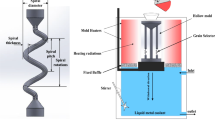Abstract
The Taguchi method, as a design of experiment (DOE) technique, was used to develop squeeze cast high strength aluminum alloys containing elements of Si, Cu, Ni and Sr. The designed aluminum-based experimental alloys possess four factors: Si, Cu, Ni and Sr contents with three different levels of weight percentages (Si: 6, 9, 12%, Cu: 3, 5, 7%, Sr: 0.01, 0.02, 0.03% and Ni: 0.5, 1, 1.5%). Tensile properties including ultimate tensile strength, yield strength and elongation at failure were selected as three individual responses to evaluate the engineering performance of the designed alloys. An analysis of the mean of signal-to-noise (S/N) ratio implies that the tensile properties of the tested aluminum alloys are influenced significantly by the levels of the alloying elements in the Taguchi orthogonal array. The optimized major element content for the as-cast high strength aluminum alloy are 9% Si, 7% Cu, 0.03% Sr and 1.0% Ni. The percentage contribution of each factor is determined by the analysis of variance (ANOVA). The results indicate that the contents of Si and Ni are the most significant two factors influencing the tensile properties of the experimented alloys.
Access this chapter
Tax calculation will be finalised at checkout
Purchases are for personal use only
Similar content being viewed by others
References
Cho YH, Joo DH, Kim CH, Lee HC (2006) The effect of alloy addition on the high temperature properties of over-aged Al-Si (CuNiMg) cast alloys. Mater Sci Forum 519:461–466
Rajaram G, Kumaran S, Rao TS (2011) Effect of graphite and transition elements (Cu, Ni) on high temperature tensile behaviour of Al–Si alloys. Mater Chem Phys 128(1):62–69
Pratheesh K, Kanjirathinkal A, Joseph MA, Ravi M (2015) Study on the effects of squeeze pressure on mechanical properties and wear characteristics of near eutectic Al–Si–Cu–Mg–Ni piston alloy with variable Mg content. Trans Indian Inst Met 68(1):59–66
Chen C-L, Richter A, Thomson RC (2010) Investigation of mechanical properties of intermetallic phases in multi-component Al–Si alloys using hot-stage nanoindentation. Intermetallics 18(4):499–508
Li Y, Yang Y, Wu Y, Wang L, Liu X (2010) Quantitative comparison of three Ni-containing phases to the elevated-temperature properties of Al–Si piston alloys. Mater Sci Eng, A 527(26):7132–7137
Chen CL, Richter A, Thomson RC (2009) Mechanical properties of intermetallic phases in multi-component Al–Si alloys using nanoindentation. Intermetallics 17(8):634–641
Wang L, Makhlouf M, Apelian D (1995) Aluminium die casting alloys: alloy composition, microstructure, and properties-performance relationships. Int Mater Rev 40(6):221–238
Hu H, Wang Y, Chu Y, Cheng P, Alpas AT (2005) Solution heat treatment of vacuum high pressure die cast aluminum alloy A380. NADCA Trans 22–33
Gruzelski JE, Closset BE (1990) The treatment of liquid aluminium–silicon alloys. Foundry Society, Amer
Dahle AK, Nogita K, McDonald SD, Zindel JW and Hogan LM (2001) Eutectic nucleation and growth in hypoeutectic Al-Si alloys at different strontium levels. Metall Mater Trans A 32(4):949–960
Heusler L, Schneider W (2002) Influence of alloying elements on the thermal analysis results of Al–Si cast alloys. J Light Met 2(1):17–26
Wang G, Bian X, Wang W, Zhang J (2003) Influence of Cu and minor elements on solution treatment of Al–Si–Cu–Mg cast alloys. Mater Lett 57(24):4083–4087
Dahle AK, Nogita K, McDonald SD, Dinnis C, Lu L (2005) Eutectic modification and microstructure development in Al–Si alloys. Mater Sci Eng A 413:243–248
Shabestari SG, Ghodrat S (2007) Assessment of modification and formation of intermetallic compounds in aluminum alloy using thermal analysis. Mater Sci Eng A 467(1):150–158
Cho YH, Lee HC, Oh KH, Dahle AK (2008) Effect of strontium and phosphorus on eutectic Al-Si nucleation and formation of β-Al5FeSi in hypoeutectic Al-Si foundry alloys. Metall Mater Trans A 39(10):2435–2448
Timpel M, Wanderka N, Kumar GV, Banhart J (2011) Microstructural investigation of Sr-modified Al–15wt% Si alloys in the range from micrometer to atomic scale. Ultramicroscopy 111(6):695–700
Stunova BB (2012) Study of AlSi10 Mg alloy structures after modification by various Sr agents. MM Sci J 318–320
Sarada BN, Srinivasamurthy PL, Swetha (2013) Microstructural characteristics of Sr and Na modified Al-Mg-Si alloy. Int J Innov Res Sci Eng Tech 2(8):3975–3983
Phadke MS (1995) Quality engineering using robust design. Prentice Hall PTR
Ross PJ (1996) Taguchi techniques for quality engineering: loss function, orthogonal experiments, parameter and tolerance design
Acknowledgements
The authors would like to take this opportunity to thank the Natural Sciences and Engineering Research Council of Canada, Ford Motor Company of Canada, and the University of Windsor for supporting this work.
Author information
Authors and Affiliations
Corresponding author
Editor information
Editors and Affiliations
Rights and permissions
Copyright information
© 2018 The Minerals, Metals & Materials Society
About this paper
Cite this paper
Fang, L., Ren, L., Geng, X., Hu, H., Nie, X., Tjong, J. (2018). Development of Novel Squeeze Cast High Tensile Strength Al–Si–Cu–Ni–Sr Alloys. In: & Materials Society, T. (eds) TMS 2018 147th Annual Meeting & Exhibition Supplemental Proceedings. TMS 2018. The Minerals, Metals & Materials Series. Springer, Cham. https://doi.org/10.1007/978-3-319-72526-0_72
Download citation
DOI: https://doi.org/10.1007/978-3-319-72526-0_72
Published:
Publisher Name: Springer, Cham
Print ISBN: 978-3-319-72525-3
Online ISBN: 978-3-319-72526-0
eBook Packages: Chemistry and Materials ScienceChemistry and Material Science (R0)




